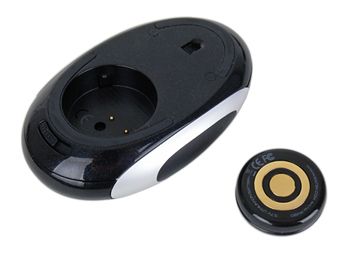| Saitek Obsidian Wireless Mouse |
Specifications:
At first glance, you will immediately notice the lack of a scroll wheel- this is one of the main features of the mouse as they replaced the traditional wheel with an all new touch sensitive scrolling area. You might also notice that the mouse is perfectly symmetric down the center - making it compatible with both the left and right-handed. Taking another look at the mouse you will see that the main body has a finished surface that is black with silver specs in it, giving it the same quality as the obsidian rock. Just on the outside of those is a thin silver edging and on the sides of the mouse is the two side buttons, most commonly used for the forward and back operation while surfing the web. Now let’s move on and talk about the specifications of the mouse.

- 4-mode, touch-sensitive scroll function
- Recharge cradle with wireless transmitter storage and spare battery recharge
- 5 buttons
- 1000 dpi resolution minimum
- Interference-free 2.4GHz wireless technology
- Smooth glide action
- 24/7 recharge solution using 2 x Li-ion battery packs
- Plug and play; ease of use and set-up

The Obsidian works in both Windows and Mac’s OS X operating systems. Its swappable batteries each last an average of 8-10 hours and only take 2 hours to charge, allowing you to always have a fully charged battery ready once the current one goes dead. The wireless interface uses 2.4GHz technology and has an operating range up to 30ft. As with all mice, this has left and right click buttons. What is interesting here, however, are the touch sensitive areas in the center of the mouse. This replaces the scroll wheel, scroll wheel button, and fast speed scroll buttons that have become a common feature on higher end mice today. Also what makes the Obsidian’s docking cradle unique compared to other wireless mice is that the USB wireless interface is removable. This was good when I had the mouse hooked up to my desktop pc and wanted to temporarily use the mouse on my laptop. So instead of unplugging the whole cradle from the back of my pc, I was able to easily unplug the USB wireless transmitter from the cradle and plug that into my laptop.
Performance:
The Obsidian has a very low profile allowing you to keep your hand straighter and not arched as much compared to normal mice. With this design I was able to get optimum performance out of the mouse. When testing it in games and normal applications the mouse worked fine for me; the only real problem that I encountered was using the touch sensitive scroll. It was difficult at first but after a few hours of using it, I did get the hang of it and then it wasn’t that hard to use. The 1000 dots per inch ( DPI ) was fine with the normal apps and for the games I was playing, but many people like to use 2000 DPI for gaming.






